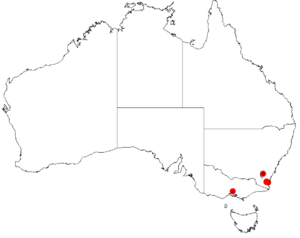Blay's wattle facts for kids
Quick facts for kids Blay's wattle |
|
|---|---|
 |
|
| Scientific classification | |
| Genus: |
Acacia
|
| Species: |
blayana
|
 |
|
| Occurrence data from AVH | |
| Synonyms | |
|
|
Acacia blayana, commonly known as Blay's wattle or Brogo wattle, is a type of tree from the Acacia family. It grows naturally in southeastern Australia.
Contents
About Blay's Wattle
This tree can grow quite tall, reaching up to 25 meters (about 82 feet). Its trunk can be around 36 centimeters (14 inches) wide. It stands straight and has smooth, dark grey bark.
Its branches point upwards and can be green, brown, or purplish. The leaves, including their stalks, are usually 1.3 to 4.5 centimeters long. They might have a few hairs or be completely smooth.
The leaves are made up of smaller parts called pinnae, which come in two to four pairs. Each pinna is 4 to 8 centimeters long. These pinnae have even smaller leaflets called pinnules. There are 6 to 14 pairs of pinnules. They are narrow and shaped like an ellipse or a spear tip. Each pinnule is 10 to 34 millimeters long and 1.5 to 4 millimeters wide.
Flowers and Seeds
Blay's Wattle produces bright yellow flowers. These flowers grow in round clusters, about 5 to 9 millimeters wide. Each cluster contains 12 to 30 flowers. The flowers appear in spring, usually between September and October.
After the flowers bloom, between November and December, flat seed pods form. These pods are brown, bluish, or purplish-brown and feel like leather. They are straight or slightly curved, measuring 4 to 11.5 centimeters long and 7 to 11 millimeters wide.
How Blay's Wattle Got Its Name
This tree was first officially described by two botanists, Mary Tindale and Arthur Bertram Court, in 1990. They published their findings in a science journal called Telopea.
Later, in 2003, another botanist named Leslie Pedley reclassified it. But in 2006, it was moved back to the Acacia group.
The very first sample of this tree was collected by a person named John Blay in 1982. He found it near the Brogo River in New South Wales. The species is named after him, John Blay, who collected the sample.
Where Blay's Wattle Grows
A. blayana is found only on the eastern side of the Great Dividing Range in Australia. It grows in Wadbilliga National Park, which is a very steep and mountainous area.
It prefers shallow, rocky soils. You can often find it growing near tall eucalyptus trees. This plant is quite rare. It sometimes grows by itself or alongside other trees like Acacia mearnsii, different types of Eucalyptus, and Tristaniopsis laurina.

